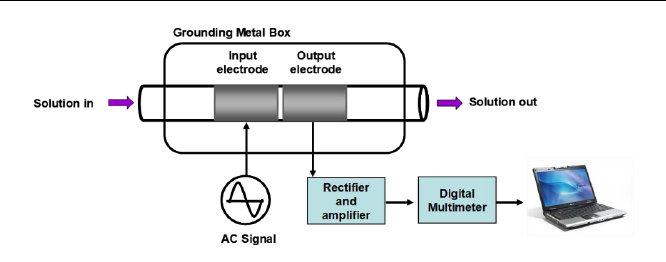การใช้คุณสมบัติไดอิเล็กทริกในการตอบสนองต่อสารเคมีและการวัดปริมาณ
Main Article Content
บทคัดย่อ
งานวิจัยนี้เสนอการใช้คุณสมบัติไดอิเล็กทริกในการตอบสนองต่อสารเคมีและการวัดปริมาณในตัวอย่างของเหลว โดยได้เลือกของเหลวประเภทสารละลายผสมสองชนิดมาใช้เพื่อสาธิตความสามารถและประสิทธิภาพของหลักการวัด สำหรับสารละลายผสมสองชนิดซึ่งแต่ละองค์ประกอบมีค่าไดอิเล็กทริกที่ต่างกันนั้น ส่งผลให้ค่าไดอิเล็กทริก รวมของระบบเปลี่ยนแปลงไปซึ่งเกิดจากการผลรวมของค่าไดอิเล็กทริกขององค์ประกอบทั้งสอง หากเราสามารถติดตามการเปลี่ยนแปลงของสัญญาณตอบสนองใด ๆ อันเกิดจากการเปลี่ยนแปลงไดอิเล็กทริกได้ เราจะสามารถทำการวิเคราะห์เชิงปริมาณทางเคมีได้ ในงานนี้ ผู้วิจัยประยุกต์ตัวตรวจวัดการนำไฟฟ้าแบบไม่สัมผัสสารละลาย หรือที่เรียกว่า capacitively coupled contactless conductivity detector (C4D) มาใช้กับการวัดเชิงปริมาณทางเคมีในตัวอย่างสารละลายผสมสองชนิด ผู้วิจัยได้สร้างตัวตรวจวัด C4D ขึ้นใช้เอง ทำด้วยท่อพอลิเททระฟลูออโรเอทิลีน หรือ PTFE ที่ป้ายด้วยหมึกโลหะหรือแถบโลหะบริเวณด้านนอก เพื่อให้บางส่วนนำไฟฟ้าได้และทำหน้าที่เป็นอิเล็กโทรดด้านนอกจำนวน 2 อิเล็กโทรด โดยได้ศึกษาปัจจัยที่มีผลต่อคุณสมบัติของตัวตรวจวัดที่ได้สร้างขึ้นนี้ ได้แก่ ความถี่และศักย์ไฟฟ้าของสัญญาณที่ให้กับอิเล็กโทรด ขนาดของท่อที่ใช้สร้างตัวตรวจวัด C4D และชนิดของโลหะที่นำมาใช้เป็นอิเล็กโทรด ตัวตรวจวัด C4D จะให้สัญญาณเปลี่ยนแปลงจากตัวทำละลายเมื่อสารละลายมาตรฐานหรือสารละลายตัวอย่างไหลผ่านบริเวณที่มีอิเล็กโทรด การเปลี่ยนแปลงสัดส่วนขององค์ประกอบในสารละลายผสมระหว่างแอลกอฮอล์และน้ำ ส่งผลให้เกิดการเปลี่ยนแปลงของสัญญาณตอบสนองจากตัวแปรอิมพีแดนซ์ (Z) ซึ่งสามารถนำไปใช้ในการวิเคราะห์หาปริมาณได้โดยการสร้างความสัมพันธ์ระหว่างสัญญาณตอบสนองของ C4D กับความเข้มข้นของแอลกอฮอล์ที่มีน้ำเป็นตัวทำละลายได้ ผลการวิเคราะห์ปริมาณแอลกอฮอล์ในกลุ่มตัวอย่างแอลกอฮอล์ล้างแผลด้วยตัวตรวจวัด C4D นี้ให้ค่าไม่แตกต่างอย่างมีนัยสำคัญกับวิธีแก๊สโครมาโตรกราฟี นอกจากนี้ ตัวตรวจวัด C4D ยังสามารถอ่านผลได้ทันที ใช้งานง่ายและทนต่อสารเคมี จึงเหมาะแก่การพัฒนาเป็นเครื่องมือภาคสนามเพื่องานควบคุมคุณภาพซึ่งสามารถนำไปติดตั้งในโรงงานผลิต รวมถึงการใช้ในการวัดภายในห้องปฏิบัติการได้อีกด้วย
Article Details

อนุญาตภายใต้เงื่อนไข Creative Commons Attribution-NonCommercial-NoDerivatives 4.0 International License.
วารสารวิทยาศาสตร์และวิทยาศาสตร์ศึกษา (JSSE) เป็นผู้ถือลิสิทธิ์บทความทุกบทความที่เผยแพร่ใน JSSE นี้ ทั้งนี้ ผู้เขียนจะต้องส่งแบบโอนลิขสิทธิ์บทความฉบับที่มีรายมือชื่อของผู้เขียนหลักหรือผู้ที่ได้รับมอบอำนาจแทนผู้เขียนทุกนให้กับ JSSE ก่อนที่บทความจะมีการเผยแพร่ผ่านเว็บไซต์ของวารสาร
แบบโอนลิขสิทธิ์บทความ (Copyright Transfer Form)
ทางวารสาร JSSE ได้กำหนดให้มีการกรอกแบบโอนลิขสิทธิ์บทความให้ครบถ้วนและส่งมายังกองบรรณาธิการในข้อมูลเสริม (supplementary data) พร้อมกับนิพนธ์ต้นฉบับ (manuscript) ที่ส่งมาขอรับการตีพิมพ์ ทั้งนี้ ผู้เขียนหลัก (corresponding authors) หรือผู้รับมอบอำนาจ (ในฐานะตัวแทนของผู้เขียนทุกคน) สามารถดำเนินการโอนลิขสิทธิ์บทความแทนผู้เขียนทั้งหมดได้ ซึ่งสามารถอัพโหลดไฟล์บทความต้นฉบับ (Manuscript) และไฟล์แบบโอนลิขสิทธิ์บทความ (Copyright Transfer Form) ในเมนู “Upload Submission” ดังนี้
1. อัพโหลดไฟล์บทความต้นฉบับ (Manuscript) ในเมนูย่อย Article Component > Article Text
2. อัพโหลดไฟล์แบบโอนลิขสิทธิ์บทความ (Copyright Transfer Form) ในเมนูย่อย Article Component > Other
ดาวน์โหลด ไฟล์แบบโอนลิขสิทธิ์บทความ (Copyright Transfer Form)
เอกสารอ้างอิง
The Secretariat of the Cabinet. (2020). Notification of the Ministry of Public Health. Retrieved 22 July 2023, from Ratchakitcha: https://ratchakitcha.soc.go.th/documents/17123828.pdf
Fracassi Da Silva, J. A. and Do Lago, C. L. (1998). An Oscillometric Detector for Capillary Electrophoresis. Analytical Chemistry, 70(20), 4339-4343.
Govinda Raju, G. R. (1988). In Dielectric constant of binary mixtures of liquids, Electrical Insulation and Dielectric Phenomena. Annual Report., Conference on, 1988, 357-363.
Reynolds, J. A. and Hough, J. M. (1957) Formulae for Dielectric Constant of Mixtures. Proceeding of the Physical Society Section B, 70, 769-774.
Jayalaxmi, Y., Guha, S., Vani, V. C. and Gopal. E. S. R. (1987). The dielectric constant of the binary liquid system n heptane + methanol near its critical temperature. Pramana, 28(3), 269-275.
Meyers, C. (2021). Ethanol and isopropanol inactivation of human coronavirus on hard surfaces. Journal of Hospital Infection, 107, 45-49.
Sengwa, R. J. and Sankhla, S. (2007). Dielectric properties of binary and ternary mixtures of alcohols: Analysis of H-bonded interaction in complex systems. Journal of Non-Crystalline Solids, 353(47-51), 4570-4574.
Smith, R. L., Lee, S. B., Komori, H. and Arai, K. (1998). Relative permittivity and dielectric relaxation in aqueous alcohol solutions. Fluid Phase Equilibria, 144(1-2), 315-322.
Wang, P. and Anderko, A. (2001) Computation of dielectric constants of solvent mixtures and electrolyte solutions. Fluid Phase Equilibria, 186(1-2), 103-122.
Yang, L. J., Yang, X. Q., Huang, K. M., Jia, G. Z. and Shuang, H. (2009). Dielectric Properties of Binary Solvent Mixtures of Dimethyl Sulfoxide with Water. International Journal of Molecular Sciences, 10(3), 1261-1270.
Zemann, A. J., Schnell, E., Volgger, D., and Bonn, G. K. (1998). Contactless Conductivity Detection for Capillary Electrophoresis. Analytical Chemistry, 70(3), 563-567.


